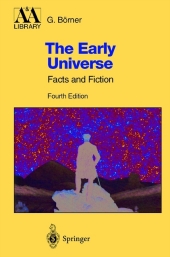 Neuerscheinungen 2011Stand: 2020-01-07 |
Schnellsuche
ISBN/Stichwort/Autor
|
Herderstraße 10
10625 Berlin
Tel.: 030 315 714 16
Fax 030 315 714 14
info@buchspektrum.de |

Gerhard Börner
The Early Universe
Facts and Fiction
4th ed. 2003. Corr. 2nd printing. 2011. xvii, 593 S. 242 SW-Abb. 235 mm
Verlag/Jahr: SPRINGER, BERLIN 2011
ISBN: 3-642-07915-6 (3642079156)
Neue ISBN: 978-3-642-07915-3 (9783642079153)
Preis und Lieferzeit: Bitte klicken
This fourth edition of Börner´s "The Early Universe" is practically a new book, not just an updated version. In particular, to meet the wishes of many readers, it is now organized so as to make it more useful as a textbook. Problem sections are also added. In the center are the connections between particle physics and cosmology: the standard model, some basic implications of quantum field theory, and the questions of structure formation. A special feature of the book is the comparison of theoretical predictions with observations, separating "facts from fiction". Special emphasis is given to the observed anisotropies of the cosmic microwave background and the consequences drawn for cosmology and for the structure formation models. Nuclear and particle physicists and astrophysicists, researchers and teachers as well as graduate students will welcome this new edition of a classic text and reference.
In this corrected reprint first year results from WMAP have been added to take account of recent developments.
I. The Standard Big-Bang Model.- 1. The Cosmological Models.- 2. Facts - Observations of Cosmological Significance.- 3. Thermodynamics of the Early Universe in the Classical Hot Big-Bang Picture.- 4. Can the Standard Model Be Verified Experimentally?.- II. Particle Physics and Cosmology.- 5. Gauge Theories and the Standard Model.- 6. Grand Unification Schemes.- 7. Relic Particles from the Early Universe.- 8. Baryon Synthesis.- 9. The Inflationary Universe.- III. Dark Matter and Galaxy Formation.- 10. Typical Scales - From Observation and Theory.- 11. The Evolution of Small Perturbations.- 12. Non-linear Structure Formation.- A. The Gauge-Invariant Theory of Perturbations.- A.1 The "3+1" Formalism.- A.1.1 Unperturbed Solutions.- A.1.2 Small Perturbations.- A.3 Gauge-Invariant Variables.- A.4 Linearized Einstein Equations for Gauge-Invariant Variables.- A.5 The General Solution.- B. Recent Developments First Year Results from WMAP.- B.1 Temperature Anisotropies.- B.2 Polarization Signal.- References.
From the reviews:
"Written in a style accessible to graduate (even advanced undergraduate) students, yet so densely informative as to be valuable also to the author´s professional peers ... A splendid accomplishment; a pleasure to study in detail, but fun also simply to browse in." SciTech Book News


